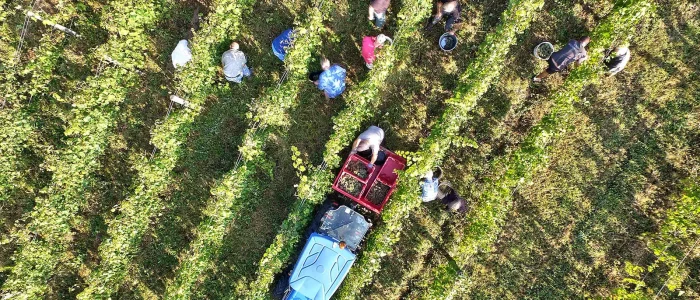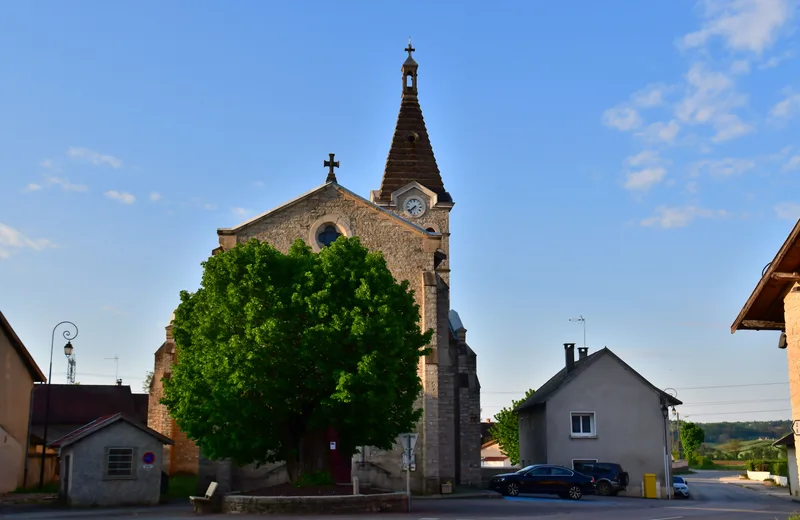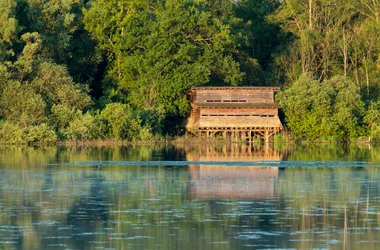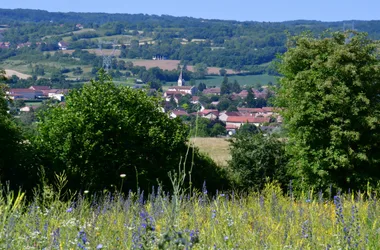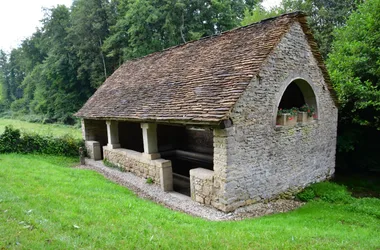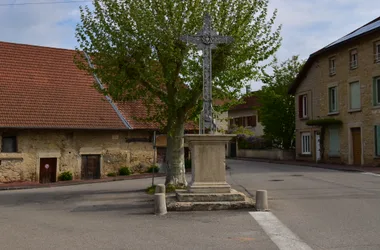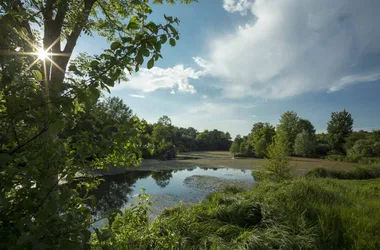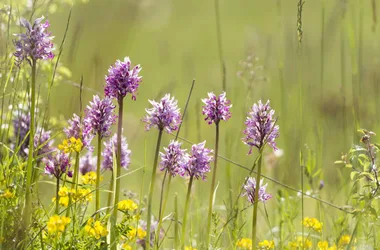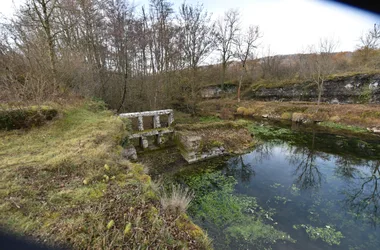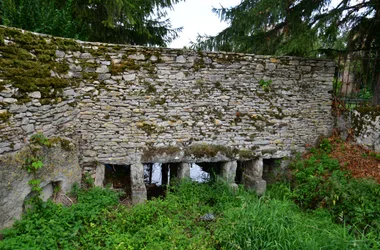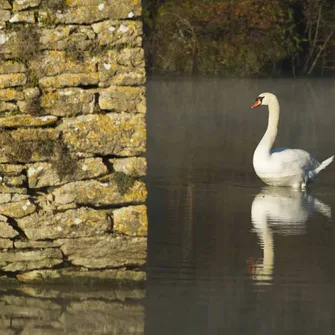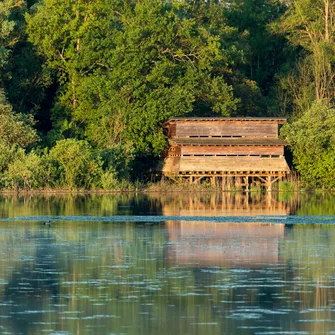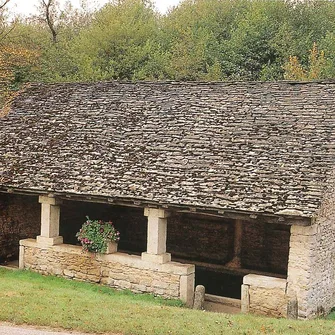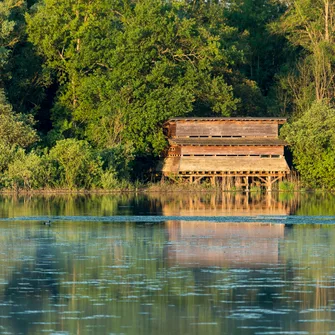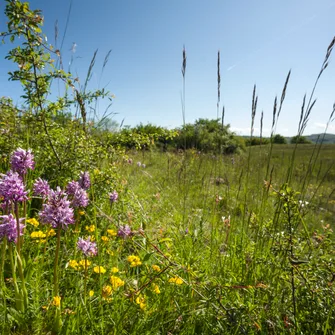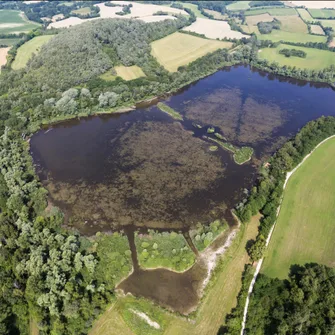Discover the town of Optevoz in the center of the Balcons du Dauphiné. Its history, inseparable from the landscape painters of the 19th and 20th centuries, is rich in an important heritage. The town also has two Sensitive Natural Areas.
1. Optevoz and its heritage
– Between history and painting: the town was a place of inspiration for many painters from Lyon, such as Ravier or Appian, and Parisians, such as Daubigny or Corot. The most emblematic of the commune is Charles-François Daubigny, who painted several paintings of Optevoz, therefore “the hamlet of Optevoz” today exhibited at the MET (Metropolitan Museum of Art) in New York.
The Auberge des Peintres restaurant houses a permanent exhibition which traces this flourishing artistic era.
The village is station 5 of the “Painters’ Route”, a road route which crisscrosses the territory allowing you to discover the favorite places of around a hundred artists.
All these painters were inspired by the landscapes of the territory for their works from the mid-19th century to the beginning of the 20th century (notebook with itinerary and explanation*).
– The territory has been occupied since the end of the Bronze Age, as evidenced by certain objects discovered at a place called Les Planches.
Other objects dating from the Roman era in a villa, called Paradis, to the northwest of the village, as well as burials from the early Middle Ages were also unearthed.
INRAP's numerous excavation campaigns have made it possible to identify the existence of an ancient settlement in Optevoz between the 1st century and the 4th century AD.
At Chemin de la Cure Bataillier, surveys showed a medieval occupation: pits and postholes.
– The church of Saint-Symphorien: from the 19th century, listed in the General Inventory of Cultural Heritage.
– Optevoz castle (private site, cannot be visited):
The first owner mentioned in 1404 was Pierre, lord of Optevoz. In 1580, the castle passed into the hands of the Montchalin family, originally from Burgundy.
It was through the marriage of Marie-Anne Rose de la Balme de Montchalin in 1703, which brought it as a dowry to her future husband, that it was united with the possessions of the lords of Courtenay until 1886.
The 1635th century fortified house is much more important than the current building. In a will from XNUMX, the existence of a Sainte-Anne chapel in a tower of the keep which has now disappeared is mentioned in particular. Of this building, only a tower to the north and the Romanesque entrance porch remain.
The fortified house was pillaged and burned in the 18th century. The lords of Courtenay rebuilt it and gave it its current appearance.
In 1891, the property was sold to the Ruffieu family who made some modifications: opening in the south wall for access to the farmyard, construction of a low wall between the castle and the farm, as well as the addition of a porch topped with a terrace.
In 1936, the Ruffeu family sold the majority of their land to residents.
Finally, other families took possession of the castle and the park, and have succeeded one another since the middle of the 20th century.
– The Optevoz washhouse: from the 19th century, impressive by its size and especially by its large framework supporting a slate roof.
– A bread oven and a water trough complete the vernacular heritage.
– For the record, the wheat mill called Moulin d'Ollier or Moulin des Gobilles: first half of the 17th century. In the 19th century, it was used for the manufacture of balls (gobilles) used in stone crushers in cement factories.
Undoubtedly destroyed during the flood of 1888, following which the Tuille pond was enlarged.
The lock, south of the mill, inspired the painters Courbet and Sisley.
2. Optevoz, nature side: two Sensitive Natural Areas*
– ENS of the Etang de Lemps: emblematic site of Isle Crémieu, this ENS offers an ideal habitat for rare and preserved fauna and flora, including the pond turtle.
A 3 km thematic trail allows you to go around the pond from the car park at the entrance to the site. You can also hike from the center of Optevoz using a 9,7 km marked trail of medium difficulty.
The thematic trail and an observatory accessible to people with reduced mobility.
The Lemps pond is also an excellent spot for observing a variety of birds in their natural environment thanks to a wooden observatory.
For the more playful, complete the orientation courses for adults and children using the booklets (4,5 km; loop; duration: 1h15), to download or collect from the Balcons du Dauphiné Tourist Office.
The pond has inspired many painters such as Camille Corot, François-Auguste Ravier and Charles-François Daubigny.
– ENS du Val d'Amby: remarkable natural site which is home to rare species such as the fragrant orchis but also birds such as the swift warbler, the wagtail or the great tit.
To be discovered thanks to a 1.7 km walking route but also from the center of Optevoz via a 4,6 km marked trail of easy level.
For the most curious, take with you the educational booklet which will accompany you along the discovery trail (4,6 km).
On the village square, you will also find a Linden tree called Sully, more than 400 years old.
* Activities are regularly organized in the local ENS. Information and registration at the Balcons du Dauphiné Tourist Office.
– Between history and painting: the town was a place of inspiration for many painters from Lyon, such as Ravier or Appian, and Parisians, such as Daubigny or Corot. The most emblematic of the commune is Charles-François Daubigny, who painted several paintings of Optevoz, therefore “the hamlet of Optevoz” today exhibited at the MET (Metropolitan Museum of Art) in New York.
The Auberge des Peintres restaurant houses a permanent exhibition which traces this flourishing artistic era.
The village is station 5 of the “Painters’ Route”, a road route which crisscrosses the territory allowing you to discover the favorite places of around a hundred artists.
All these painters were inspired by the landscapes of the territory for their works from the mid-19th century to the beginning of the 20th century (notebook with itinerary and explanation*).
– The territory has been occupied since the end of the Bronze Age, as evidenced by certain objects discovered at a place called Les Planches.
Other objects dating from the Roman era in a villa, called Paradis, to the northwest of the village, as well as burials from the early Middle Ages were also unearthed.
INRAP's numerous excavation campaigns have made it possible to identify the existence of an ancient settlement in Optevoz between the 1st century and the 4th century AD.
At Chemin de la Cure Bataillier, surveys showed a medieval occupation: pits and postholes.
– The church of Saint-Symphorien: from the 19th century, listed in the General Inventory of Cultural Heritage.
– Optevoz castle (private site, cannot be visited):
The first owner mentioned in 1404 was Pierre, lord of Optevoz. In 1580, the castle passed into the hands of the Montchalin family, originally from Burgundy.
It was through the marriage of Marie-Anne Rose de la Balme de Montchalin in 1703, which brought it as a dowry to her future husband, that it was united with the possessions of the lords of Courtenay until 1886.
The 1635th century fortified house is much more important than the current building. In a will from XNUMX, the existence of a Sainte-Anne chapel in a tower of the keep which has now disappeared is mentioned in particular. Of this building, only a tower to the north and the Romanesque entrance porch remain.
The fortified house was pillaged and burned in the 18th century. The lords of Courtenay rebuilt it and gave it its current appearance.
In 1891, the property was sold to the Ruffieu family who made some modifications: opening in the south wall for access to the farmyard, construction of a low wall between the castle and the farm, as well as the addition of a porch topped with a terrace.
In 1936, the Ruffeu family sold the majority of their land to residents.
Finally, other families took possession of the castle and the park, and have succeeded one another since the middle of the 20th century.
– The Optevoz washhouse: from the 19th century, impressive by its size and especially by its large framework supporting a slate roof.
– A bread oven and a water trough complete the vernacular heritage.
– For the record, the wheat mill called Moulin d'Ollier or Moulin des Gobilles: first half of the 17th century. In the 19th century, it was used for the manufacture of balls (gobilles) used in stone crushers in cement factories.
Undoubtedly destroyed during the flood of 1888, following which the Tuille pond was enlarged.
The lock, south of the mill, inspired the painters Courbet and Sisley.
2. Optevoz, nature side: two Sensitive Natural Areas*
– ENS of the Etang de Lemps: emblematic site of Isle Crémieu, this ENS offers an ideal habitat for rare and preserved fauna and flora, including the pond turtle.
A 3 km thematic trail allows you to go around the pond from the car park at the entrance to the site. You can also hike from the center of Optevoz using a 9,7 km marked trail of medium difficulty.
The thematic trail and an observatory accessible to people with reduced mobility.
The Lemps pond is also an excellent spot for observing a variety of birds in their natural environment thanks to a wooden observatory.
For the more playful, complete the orientation courses for adults and children using the booklets (4,5 km; loop; duration: 1h15), to download or collect from the Balcons du Dauphiné Tourist Office.
The pond has inspired many painters such as Camille Corot, François-Auguste Ravier and Charles-François Daubigny.
– ENS du Val d'Amby: remarkable natural site which is home to rare species such as the fragrant orchis but also birds such as the swift warbler, the wagtail or the great tit.
To be discovered thanks to a 1.7 km walking route but also from the center of Optevoz via a 4,6 km marked trail of easy level.
For the most curious, take with you the educational booklet which will accompany you along the discovery trail (4,6 km).
On the village square, you will also find a Linden tree called Sully, more than 400 years old.
* Activities are regularly organized in the local ENS. Information and registration at the Balcons du Dauphiné Tourist Office.
Themes:
Visit
Individual visit services
- Unguided individual tours permanently
Opening
| Opening hours from January 01 to December 31, 2024 | |
|---|---|
| Monday | Open |
| Tuesday | Open |
| Wednesday | Open |
| Thursday | Open |
| Friday | Open |
| Saturday | Open |
| Sunday | Open |
Prices
Free access.
Services
Equipments
Activities on site
- Orientation course
Linked offers
On the spot…
